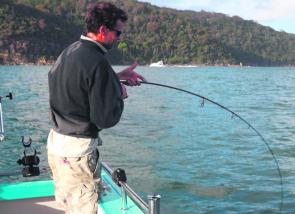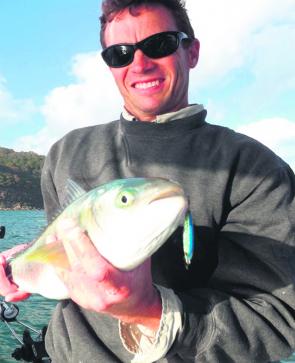Where did the Summer go? What happened to it?
We have seen more green, cloudy water this season than clear blue stuff and that has really made the fishing a bit tricky, to say the least.
The water is warm and there seem to be plenty of baitfish but the predators are hard to find and harder to entice.
With fingers crossed as I write, I hope that soon we will see the blue water bump into our part of the world and liven up Pittwater and Broken Bay.
This month we will hopefully see some of the bigger kingfish that normally are along the coast come into Pittwater, giving the flat-water fishers a chance at a catch of a lifetime.
This is when we normally see these metre-plus fish cruising the shallows, chasing squid around the weed beds.
This is why at this time of the year we catch live squid and use the really big ones on the downriggers. Big kings love big squid and downrigging is a great way to cover ground.
Casting poppers and big soft plastics can also attract the attention of these inquisitive fish. Just remember that if you are going to target bigger kings, bring heavy gear because they do make 50lb to 60lb braid with 15kg of drag look like breaming gear.
We should also start to see some bonito enter the river and fingers crossed that the netters miss out on a few salmon schools so they too can become reliable targets.
If you are after a feed there are quite a few flathead lurking on the drop-offs along Pittwater and the Hawkesbury.
Flathead are great targets, especially if you are enjoying time with the family. These are some of the easiest species of table fish to catch if you follow a few simple tips.
Make sure that you cover ground and concentrate your effort at points along the river, drop-offs along beachfronts, channels and sand or mud bars.
Flathead will be buried in the sand or mud waiting for something to eat.
These fish sit with their heads into the current so it is easy just to drift with the current.
If there is a strong wind blowing you in the opposite direction you may need to use a sea anchor so the run will pull you along, instead of the wind taking you somewhere you don’t want to go.
Another tip is to make sure that your sinker puffs up the sand as you drift along. The commotion caused by the sinker is the first thing that a flathead usually notices and when a tasty fresh mullet, yellowtail or even a pilchard is on a hook not far behind, it is hard to refuse.
If I am going to use dead fish as bait, such as a pilchard, I always cut the tail off. This stops the bait from spinning like a helicopter while drifting and it also allows the fleshy oily smells to escape the bait and attract the fish.
When drifting for flathead a GPS plotter can be a great asset. The idea is that on drop-offs around Broken Bay the flathead gather in the same areas, so going back over the same spots by retracing your path can be a very effective way to build a feed.
If you like to anchor and fish, use a weighted berley bucket and in a stronger current, drop the berley bucket so it’s about a metre off the bottom.
Providing you are using an oily fish berley, the flathead will make their way up the trail to right to the bucket.
Another species to target at the moment is the jewfish, which have been showing up in numbers over the past few months around the usual areas in Broken Bay on the change of the tide.
Lion Island Reef, Flint and Steel, Juno Point, Walkers Point, Middle Ground and the channel between Juno Point and Elanoras Bluff have all produced fish.
Most are of school size but for those that want to go out and cross a jewfish off the bucket list, this may be your time.
The better fish have been caught on fresh squid heads, live or butterflied yellowtail and the smaller ones are picking up bream baits.
The Middle Ground has also been turning up good numbers of bream, the odd decent whiting and flathead but only on the change of the tide. The hot bait is live nippers.
Along the coast we are still finding pockets of kingfish from the usual headlands and reefs south of Broken Bay. Live slimy mackerel have been the best bait, when they can be found, but yellowtail are also working.
Headlands to try include Whale Headland, Newport Reef, Mona Vale and on the odd day, Long Reef.
If you are going to fish Newport Reef I urge you to be careful, especially on a dropping tide, because there are quite a few shallow rocks that are hard to see in the green water.
Along the reefs further out, the fishing has been pretty patchy but when fish are found they have on most occasions been decent.
The grounds in 80m off Long Reef have produced some snapper, flathead, morwong, nannygai and the odd jewfish.
Closer in, Boultons Reef has small nannygai and snapper but to be honest there is a heap of bait over this area and it may be worth a try in a couple of weeks. The grounds in 40m off Newport are also showing the odd snapper, marbled flathead and trag.
Reads: 1875
Light rods and big salmon equate to a lot of fun.

Broken Bay, sun, tranquillity and salmon – what more could an angler ask for?

Kids just love fishing and when a big flathead comes aboard, it’s smiles all around.




